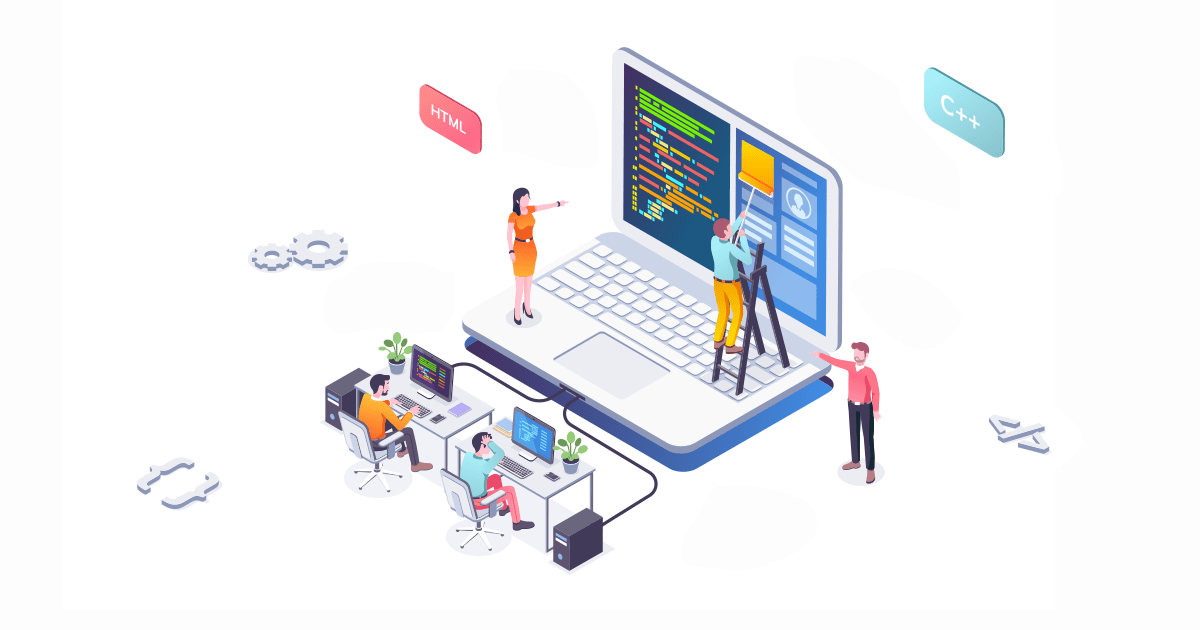Whether your organization is a department or agency with the federal, state, or local government, there is a high probability that your critical operations are supported by a legacy mainframe system. If this is the case, you have discovered that maintaining your mainframe applications has become a painful experience and will continue to be so as time marches on.
According to the Employment & Training Administration (ETA), State workforce agencies have endured many barriers to modernization, such as issues with staffing, lack of funds, and outdated technology. These issues worsened as a result of the pandemic, resulting in a surge in claims that left the system vulnerable to breakdowns, delays, and unique attacks from scammers.
"The biggest obstacle states face is the high cost of adapting systems to meet changing needs, due to how those systems are designed and managed. This leaves states with IT systems that are brittle and inflexible to new requirements, such as a sudden increase in claims volume. It also means that even “simple” changes can be prohibitively costly, time-consuming, and risky, which leaves states with an “all or nothing” choice: holding onto antiquated systems or embarking on a risky system overhaul," explains a document by the U.S. Department of Labor and ETA on IT modernization strategy.
ETA administrates more than $204 million in grants that have been recently awarded by the the U.S. Department of Labor to support strengthening and modernizing unemployment insurance systems in 18 states and the U.S. Virgin Islands. Funded by the American Rescue Plan Act, the grants will also help make these systems more reliable and accessible to users. The funds will enable recipients to adopt new strategies for upgrading and redesigning unemployment insurance programs, better defend systems against fraud and make systems easier to maintain and change. Funds will support states’ use of cloud technology to make UI systems more flexible and more user friendly.
At Astadia, we work with government departments and agencies to do just that: preserve previous investments by modernizing and migrating data and legacy applications to more cost-effective platforms that enable digital transformation.
Regardless of the mainframe modernization approach, here are six reasons why organization need to modernize mainframe applications.
1. Lower IT Costs by up to 80%
While hardware leasing costs are high, they have remained somewhat static and predictable. However, software licensing costs are volatile and difficult to calculate: you have probably been surprised by your monthly licensing bill on more than one occasion. Mainframe monthly licensing charges can eat up 30 percent of your IT mainframe operating budget. Maintenance costs are also high thanks to the costs associated with additional CPU capacity and memory.
Depending on your modernization approach, your organization can reduce IT costs by up to 80 percent and government entities that have modernized have achieved these kinds of savings. For example, with each agency’s unique modernization approach, a GAO IT Modernization Study reports that :
- The DOD avoided spending $25 million annually on hosting costs
- DHS realized a cumulative $1.6 billion in cost savings
- The Department of Treasury enhanced revenue by $759 million.
State and local government departments are also realizing substantial savings with IT modernization. For example, we were able to save the City of Miami over 50 percent, saving at least $900,000 per year.
2. Minimize the Risk of Limited IT Talent
According to a Forrester study, “mainframe-power organizations have lost 23 percent of their mainframe workforce and only replaced on of every three experts lost. The new development and operations people hired do not have the mainframe experts’ knowledge of the platform’s esoteric differences. They don’t take well to the waterfall-based culture and processes.”
As baby boomers - those who specialized in COBOL, assembly language code, and a waterfall software development methodology - retire, the new generation of IT developers are focusing on cloud platforms and other modern platforms and tools.
For example, in the GAO IT modernization study mentioned earlier, “agencies have had difficulty finding employees with such knowledge and may have to pay a premium to hire specialized staff or contractors.” The study goes on to disclose that the Social Security Administration needed to rehire retired employees to maintain its mainframe system and the IRS was experiencing staff shortages with skills to support legacy-based tax processing systems.
A shortage of mainframe-savvy development and operations personnel will put your mainframe data and applications at risk from both a performance and security perspective. Limited COBOL talent has driven many organizations to modernize.
3. Easily Transform IT and Business Operations
Using a mainframe environment for the modern applications that support your digital transformation initiatives will increase your IT costs as you add CPU and memory capacity. Worse yet, a mainframe’s hard coding of business rules means that these applications are not easily changed. And, mainframe environments cannot easily support modern technologies that have been enabled by cloud services such as Machine Learning, Advanced Analytics, and Artificial Intelligence or modern development approaches like DevOps.
As stated in a CIO article, “Under the covers, modernizing is about creating an integrated application, infrastructure, and business process stack that is no longer bolted to the proverbial data center floor…That transformation journey will involve rewriting some applications, creating brand new ones from scratch, sunsetting others and, in some cases, leaving legacy applications precisely the way they are, but in a more agile operating environment..”
With IT modernization, your organization can “gain agility with reduced development cycles via continuous integration and continuous delivery (CI/CD), and virtually unlimited infrastructure resources consumed on demand.”
4. Ensure System and Data Security
According to the GAO study, many government legacy systems “may operate with known security vulnerabilities that are either technically difficult or prohibitively expensive to address.” Worse yet, many government departments and agencies are running operating systems and applications that are no longer supported. This put the personal records and financial information of millions of federal study aid applicants at risk.
The first rule in maintaining the security of your operating systems and applications is to immediately install any software updates. These updates patch the security vulnerabilities and ensure that your systems and data are protected from cyber-security attacks, including ransomware. Unfortunately, if your operating system and/or applications are no longer supported, you won’t be getting any updates.
5. Simplify Disaster Recovery
The costs of implementing and maintaining an on-premises disaster recovery (DR) strategy in support of your mainframe environment is not only costly but complicated. If a department or agency spends $100,000 maintaining their mainframe environment, it will cost another $100,000 to maintain an on-premises, high-availability system. DR can be difficult and if multiple products are used for recovery, it makes the process more complex. Systems dependencies are difficult to map, DR exercises and testing can be time consuming, and the plethora of DR products make for more complicated training of IT staff – all increasing the risk of failure.
Unlike commodity servers and the cloud, mainframe operating systems and applications cannot be easily moved to non-mainframe systems. As a result, the backup and DR process can be complicated requiring you to routinely offload data, create backup tapes to store offsite, replicate data, implement a virtualization strategy, and spread out your mainframe resources across your organization.
With IT modernization, you can implement cloud backup and disaster recovery, which are cost-effective, convenient, and easy:
- The cloud’s storage and compute resources remain offline until they need to be deployed when a data loss or disaster occurs. This eliminates the expense associated with maintaining a private DR system.
- Many cloud service providers offer features that enable DR with just a few clicks versus the complexity associated with stitching multiple products together to support on-premises DR recovery.
- Cloud DR solutions also embed the industry’s best security features and employ security best practices. This helps reduce the risk of cyber-security attacks when compared to developing your own security requirements for an on-premises DR solution.
- Cloud backup and DR is also more secure than an on-premise solution because the cloud reduces the threat vector, that is, the surface area that is exposed to potential threats. An on-premise infrastructure and on-premise DR solution multiples the threat vector, significantly increasing an organization’s exposure.
6. Eliminate the Consequences of Being Last (or Close to it)
Many federal and state departments and agencies use IT shared services. With this model, the cost of the mainframe environment is shared by those internal customers who rely on the mainframe system(s). Shared services is designed to lower costs, achieve greater efficiencies across the organization, improve employee productivity, and provide your team with access to top talent and best practices.
While this all sounds great, keep in mind that as other departments and agencies who share these IT services modernize their IT infrastractures, they will no longer rely on shared services. As a result, the costs of an IT shared environment will be spread out over the remaining clients. This means that if you are slow to modernize, you can expect your IT costs to increase.
For example, if it costs $100,000 a month to maintain a shared services environment and there are five clients sharing the service, each client pays $20,000. However, if three of these clients modernize and move away from shared services, the $100,000 a month maintenance fee will be shared by the remaining two clients, who will pay $50,000 a month.
When you look at all the reasons why you should modernize your mainframe environment and mainframe applications, there are no reasons left NOT to modernize. Yes, there are risks associated with mainframe modernization, but these risks can be eliminated by choosing an IT modernization partner that has “been there and done that” many times and has worked with a spectrum of government departments and agencies. Yes, IT modernization costs money, but the savings can deliver a respectable return on investment (ROI) in addition to the other key benefits that we have discussed here.
Subscribe to our newsletter
Related news
Related white papers:
Let's Talk
Get in touch with our experts and find out how Astadia's range of tools and experience can support your team.
contact us now







